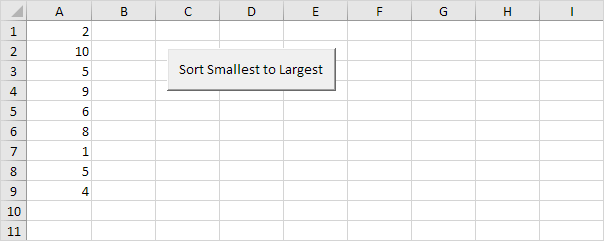Table of Contents
Sort Numbers
Below we will look at a program in Excel VBA that sorts numbers.
Situation:
Place a command button on your worksheet and add the following code lines:
1. First we declare three variables of type Integer and one Range object.
Dim i As Integer j As Integer temp As Integer rng As Range
2. We initialize the Range object rng with the numbers in column A. We use the CurrentRegion property for this. CurrentRegion is useful when we don’t know the exact boundaries of a range in advance (we want this program to work for 9 numbers but also for 90 numbers).
Set rng = Range(“A1”).CurrentRegion
3. We start two For Next loops.
For i = 1 To rng.Count
For j = i + 1 To rng.Count
Explanation: rng.Count equals 9 so the first two code lines reduce to For i = 1 to 9 and For j = i + 1 to 9. For i = 1 j = 2 3 … 8 and 9 are checked.
4. To sort the numbers properly we compare the first number with the next number. If the next number is smaller we swap the numbers. Add the following If Then statement.
If rng.Cells(j) < rng.Cells(i) Then
End If
If the above statement is true we swap the numbers.
For example: for i = 1 and j = 2 the numbers 2 and 10 are being compared. The above statement is not true. Thus no need to swap the numbers. Excel VBA increments j by 1 and repeats the code lines for i = 1 and j = 3. You can easily see that 5 is larger than 2 so still no need to swap the numbers. We get the same result for j = 4 j = 5 and j = 6. When we arrive at j = 7 the above statement is true since 1 is smaller than 2.
5. We swap the numbers. We temporarily store one number to temp so that Excel VBA can swap the numbers properly. Add the following code lines in the If statement.
‘swap numbers
temp = rng.Cells(i)
rng.Cells(i) = rng.Cells(j)
rng.Cells(j) = temp
6. We close the second For Next loop (Outside the If statement).
Next j
For i = 1 and j = 7 Excel VBA swapped the numbers. That means we get 1 at the first position and 2 at position 7. Now that we have 1 at the first position we will compare this value with 5 (for j = 8) and 4 (for j = 9). There is no need to swap the numbers (1 is the smallest number). This way Excel VBA gets (for i = 1) the smallest number at the first position. To get the second smallest number at the second position Excel VBA repeats the exact same steps for i = 2. To get the third smallest number at the third position Excel VBA repeats the exact same steps for i = 3 etc.
7. Close the first For Next loop (Outside the If statement).
Next i
8. Test your program.
Result:
9. The following code line produces the exact same result:
Range(“A1:A9”).Sort Key1:=Range(“A1”) Order1:=xlAscending Header:=xlNo
Note: this program is a great exercise. Understanding loops in Excel VBA is essential if you want to write more complicated programs in the future! Having said that you can also use the Sort method in Excel VBA to quickly sort numbers.








